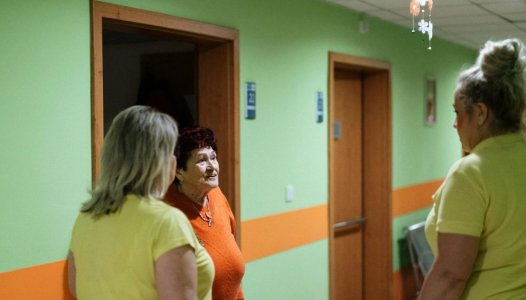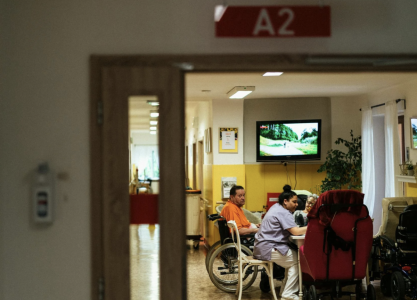Looking beyond assisted living? Here are 8 care alternatives worth exploring
By
Veronica E.
- Replies 0
Choosing the right care solution for yourself or a loved one is deeply personal—and sometimes, complex.
While assisted living offers structure and support, it may not be the best fit for every senior or family situation.
Maybe you’re hoping to stay in a familiar neighborhood, live with family, or explore more affordable, flexible care.
Fortunately, assisted living is just one of many options available.
From cozy care homes to tech-powered safety devices, there’s a world of alternatives that can help you age well—on your own terms.

Assisted living works well for many, but it’s not a one-size-fits-all solution.
Some seniors find it too structured, too expensive, or not suited to their health or lifestyle needs.
Others want to stay close to pets, family, or their current home.
And for caregivers, alternatives can provide better flexibility or peace of mind.
Whether you're planning ahead or already navigating care decisions, it’s worth exploring all the choices available.
Independent living communities are ideal for seniors who are self-sufficient but want access to amenities, a sense of community, and help with daily tasks like maintenance or transportation.
These age-restricted neighborhoods (typically 55+) often offer meal plans, social events, and optional services.
Best for: Active older adults who want to downsize and enjoy low-maintenance living.
Tip: You can combine independent living with part-time home care for added support.
CCRCs offer a full range of care under one roof.
Seniors start in independent living, then transition to assisted living, memory care, or skilled nursing as needed—without having to move to a new facility.
Best for: Seniors who want long-term continuity and peace of mind for future health changes.
Consider: Entrance fees and monthly costs can be high, but may be worth it for the long-term security.
Also known as “board and care” homes, these are residential houses where a small group of seniors receive daily assistance in a cozy, home-like setting.
Best for: Seniors who want daily support in a quiet, intimate environment.
Note: There may be fewer amenities, and accessibility can vary—be sure to ask questions.
Adult day centers offer structured activities, meals, and social engagement for older adults during the day—giving caregivers a chance to work, rest, or run errands.
Best for: Families caring for a senior at home who need daytime support or respite.
Bonus: Many centers include memory care programs and transportation services.
Respite care provides short-term stays in assisted living or skilled nursing facilities.
It allows caregivers to take time off for a vacation, medical need, or personal break.
Best for: Caregivers who need a temporary break or seniors recovering from surgery.
Extra benefit: Respite care also gives seniors a chance to “test out” a facility before committing long-term.

Home care provides help with everyday activities like bathing, cooking, errands, or companionship—all delivered right at home.
Best for: Seniors who prefer to age in place with flexible, personalized care.
Cost tip: While hourly care can be affordable, 24/7 care gets expensive. Factor in household expenses too.
Reminder: Home care is different from home health care, which involves medical services ordered by a doctor.
More families are choosing multi-generational living—either by welcoming a senior into their home or building a separate unit like a “granny flat” on their property.
Best for: Families who want close connection and shared caregiving.
Advice: Set boundaries early, divide responsibilities, and consider adding part-time professional support to avoid burnout.
From wearable medical alert systems to smart-home sensors, modern technology can help keep seniors safe while preserving their independence.
Best for: Independent seniors or family caregivers looking for an added layer of safety.
Idea: Combine devices with another option (like home care or adult day care) for a well-rounded plan.
Choosing the right care setup depends on more than just budget. Ask:
You may find that a mix of options—like home care plus adult day services, or an independent living community with a monitoring device—offers the best balance of care, independence, and cost.
Read next: How to choose the right assisted living facility: your step-by-step checklist

Have you tried any of these alternatives to assisted living? Did something unexpected work well—or not work at all? We’d love to hear your experience. Your insight could help someone else make a more confident choice for a loved one.
While assisted living offers structure and support, it may not be the best fit for every senior or family situation.
Maybe you’re hoping to stay in a familiar neighborhood, live with family, or explore more affordable, flexible care.
Fortunately, assisted living is just one of many options available.
From cozy care homes to tech-powered safety devices, there’s a world of alternatives that can help you age well—on your own terms.

Exploring alternatives to assisted living can help families find the right balance of support and independence. Image Source: Pexels / Jsme MILA.
Why consider alternatives to assisted living?
Assisted living works well for many, but it’s not a one-size-fits-all solution.
Some seniors find it too structured, too expensive, or not suited to their health or lifestyle needs.
Others want to stay close to pets, family, or their current home.
And for caregivers, alternatives can provide better flexibility or peace of mind.
Whether you're planning ahead or already navigating care decisions, it’s worth exploring all the choices available.
Also read: Assisted living qualifications: What to expect and who it’s designed for
1. Independent living: freedom with a safety net
Independent living communities are ideal for seniors who are self-sufficient but want access to amenities, a sense of community, and help with daily tasks like maintenance or transportation.
These age-restricted neighborhoods (typically 55+) often offer meal plans, social events, and optional services.
Best for: Active older adults who want to downsize and enjoy low-maintenance living.
Tip: You can combine independent living with part-time home care for added support.
2. Continuing care retirement communities (CCRCs): aging in place
CCRCs offer a full range of care under one roof.
Seniors start in independent living, then transition to assisted living, memory care, or skilled nursing as needed—without having to move to a new facility.
Best for: Seniors who want long-term continuity and peace of mind for future health changes.
Consider: Entrance fees and monthly costs can be high, but may be worth it for the long-term security.
3. Residential care homes: small-scale, personal care
Also known as “board and care” homes, these are residential houses where a small group of seniors receive daily assistance in a cozy, home-like setting.
Best for: Seniors who want daily support in a quiet, intimate environment.
Note: There may be fewer amenities, and accessibility can vary—be sure to ask questions.
Also read: Seniors can bring home a furry friend for free—and never worry about vet bills again
4. Adult day care: daytime care and connection
Adult day centers offer structured activities, meals, and social engagement for older adults during the day—giving caregivers a chance to work, rest, or run errands.
Best for: Families caring for a senior at home who need daytime support or respite.
Bonus: Many centers include memory care programs and transportation services.
5. Respite care: short-term relief for caregivers
Respite care provides short-term stays in assisted living or skilled nursing facilities.
It allows caregivers to take time off for a vacation, medical need, or personal break.
Best for: Caregivers who need a temporary break or seniors recovering from surgery.
Extra benefit: Respite care also gives seniors a chance to “test out” a facility before committing long-term.

Respite care offers short-term relief for caregivers while ensuring loved ones receive quality support. Image Source: Pexels / Jsme MILA.
Also read: What to know about senior co-ops—and whether they’re right for your next chapter
6. Home care: comfort and support at home
Home care provides help with everyday activities like bathing, cooking, errands, or companionship—all delivered right at home.
Best for: Seniors who prefer to age in place with flexible, personalized care.
Cost tip: While hourly care can be affordable, 24/7 care gets expensive. Factor in household expenses too.
Reminder: Home care is different from home health care, which involves medical services ordered by a doctor.
7. Living with family or in an accessory dwelling unit (ADU)
More families are choosing multi-generational living—either by welcoming a senior into their home or building a separate unit like a “granny flat” on their property.
Best for: Families who want close connection and shared caregiving.
Advice: Set boundaries early, divide responsibilities, and consider adding part-time professional support to avoid burnout.
8. Elderly monitoring devices: tech-based peace of mind
From wearable medical alert systems to smart-home sensors, modern technology can help keep seniors safe while preserving their independence.
Best for: Independent seniors or family caregivers looking for an added layer of safety.
Idea: Combine devices with another option (like home care or adult day care) for a well-rounded plan.
Also read: Some places might surprise you as the best for seniors living alone
How to choose the right combination of care
Choosing the right care setup depends on more than just budget. Ask:
- What level of care is needed—occasional help or hands-on daily support?
- What can your family realistically manage?
- Is social interaction a priority?
- What are the full costs (housing, food, medical needs)?
- What does your loved one want?
You may find that a mix of options—like home care plus adult day services, or an independent living community with a monitoring device—offers the best balance of care, independence, and cost.
Read next: How to choose the right assisted living facility: your step-by-step checklist
Key Takeaways
- There are many alternatives to assisted living, including independent living communities, continuing care retirement communities (CCRCs), residential care homes, adult day care, respite care, home care, family living arrangements, and elderly monitoring devices.
- Combining care options—such as adult day care with home care or independent living with monitoring devices—can provide flexible, tailored support for both seniors and caregivers.
- Short-term solutions like respite care or adult day programs offer valuable relief for family caregivers while allowing seniors to remain engaged and safe.
- When choosing care, consider the level of need, family capacity, budget, and the senior’s preferences to create a plan that prioritizes dignity, comfort, and connection.
Have you tried any of these alternatives to assisted living? Did something unexpected work well—or not work at all? We’d love to hear your experience. Your insight could help someone else make a more confident choice for a loved one.






